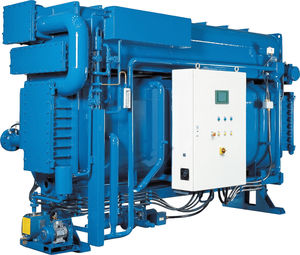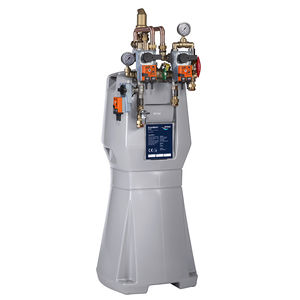
- Maritime equipment
- Interior fittings
- Ship water chiller
- Heinen & Hopman
Ship water chiller COOLING PLANT
Add to favorites
Compare this product
Characteristics
- Options
- for ships
Description
A cooling plant belongs to the main units of an air conditioning system. Without a cooling plant it will be impossible to meet a comfortable inside climate when cooling is needed. A cooling plant consist of four main components:
compressor
condenser
expansion valve
evaporator
The diagram below shows the complete cooling circuit with all the main component as well the phase of the refrigerant in each stage of the circuit.
DIRECT EXPANSION (DX) UNIT
A DX unit is mostly located near by the air handling unit to avoid long refrigerant pipe through the ship. The cooling coil inside the air handling unit operates as evaporator of the cooling plant.
CHILLED WATER UNIT (CWU)
Chiled water units are used for ships where there is a long distance between the air handling unit and the cooling plant or with several air handling units. The chilled water (mostly with a percentage of glycol) will be used as cooling medium between the evaporator and the cooling coil inside the air handling unit. An advantage of this system is that it avoids the long refrigerant pipes filled with Freon on board.
Compressor
The compressor is a mechanical device that increase the pressure of the refrigerant gas by reducing the volume.
Condenser
A condenser is a heat exchanger that extract the heat of the compressed refrigerant by transferring it to a cooling medium (air/ water). In the condenser the refrigerant transforms from its vapor to its liquid state.
Expansion valve
The expansion valve removes pressure from the liquid refrigerant to allow expansion (change the state from liquid to a vapor) in the evaporator.
Catalogs
Cooling plant
10 Pages
Related Searches
- Handler
- Ship handler
- Bilge blower
- Ship blower
- Ship air conditioning system
- Air handler
- Handler with filter
- Boat air conditioner
- Monobloc air conditioning system
- Yacht air conditioner
- Yacht treatment system
- Ship water chiller
- Self-contained air conditioning system
- Ship fan coil unit
- Purifier treatment system
- Ships heater
- Ship fire damper
- HVAC system
- Ship HVAC system
- Split air conditioner
*Prices are pre-tax. They exclude delivery charges and customs duties and do not include additional charges for installation or activation options. Prices are indicative only and may vary by country, with changes to the cost of raw materials and exchange rates.







